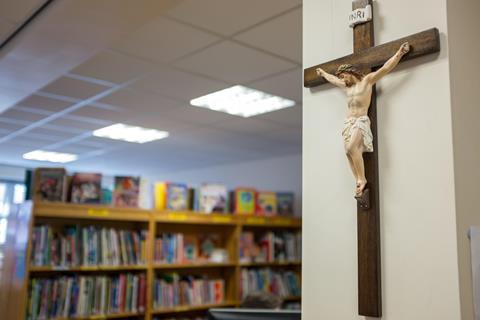New Catholic schools in England will no longer have to offer 50 per cent of their places to children of other faiths, according to a recent government announcement. James Somerville-Meikle says the news marks "a huge moment of excitement” for Catholics, and everyone who values parent choice

I recently returned from my first trip to the United States. The old saying that everything is bigger across the pond really is true. The other thing that struck me was just how visible the Catholic Church is in America.
Most of America’s leading universities are Catholic. The Catholic Church has a strong presence in health and social care. On Capitol Hill, almost 1 in 3 legislators are Catholic.
The situation in Britain is very different. The creation of the Church of England and the establishment of the welfare state, mean you need to look slightly harder to see the Catholic Church at work.
But its influence exists, and one of the areas where it is having the greatest impact is in education. Almost 1 in 10 school pupils in England are educated at a Catholic school, numbering around 850,000 young people.
Catholic schools have an important role to play in passing on the faith, and promoting the teachings of the church, but they have a much broader appeal in the communities they serve.
Around 40 per cent of pupils at Catholic schools come from other faiths or none. Catholic schools educate a higher proportion of pupils from deprived backgrounds, they are more ethnically diverse, and achieve better results on average than other state schools.
It is because of their success and popularity that the Catholic Church was uniquely affected by the faith cap that was introduced when the free school programme was set up in 2010.
Almost 1 in 10 school pupils in England are educated at a Catholic school
The cap applies where a free school with a religious character is oversubscribed. It limits the number of pupils that can be admitted on the basis of any one faith to 50 per cent.
This measure was designed to prevent radicalisation in schools, but because it only applies to schools that are oversubscribed, it has punished those schools that are particularly popular with parents beyond their faith community – largely Catholic and Jewish schools.
As Catholic schools are nearly always oversubscribed, the cap would have meant Catholic schools having to turn away pupils on the basis of their Catholic faith. It was a policy that went against Canon Law and Catholic Bishops have rightly refused to sanction the creation of new Catholic free schools while the cap was in place.
Lifting the cap was in the 2017 Conservative manifesto, but despite the change not requiring new legislation or new money from the Treasury, it has proved difficult to shift. Now the Education Secretary, Gillian Keegan, has announced her intention to lift the cap.
Ms Keegan announced the decision in a written statement to Parliament this week. While the change is subject to a seven-week public consultation, we have never been so close to lifting the cap. It is a huge moment of excitement for the Catholic community in this country, but also for everyone who values parent choice and wants to see every child have the best possible education.
There will be the usual voices of opposition from those who think that religion should have no place in society, never mind education. That is why it is so important for people of faith take part in the consultation on the plans to lift the cap, which closes on 20 June.
Since the free school programme was established, around 650 new schools have been set up across England, many in some of the most deprived parts of the country. A number of these new free schools have been supported by faith groups, including 18 Muslim schools, three Hindu schools, and several Church of England schools. But not a single Catholic free school has been able to open. This is plainly wrong.
Lifting the cap will create a level playing field and allow Catholic schools onto the pitch.
As the Americans would say, allowing Catholic free schools to open is a ‘no brainer’. While we cannot compete with America when it comes to the size of their Catholic education sector, we can at least make sure that where demand exists our schools are able to open.


































1 Reader's comment